Bird 61-38-05 Operation Manual
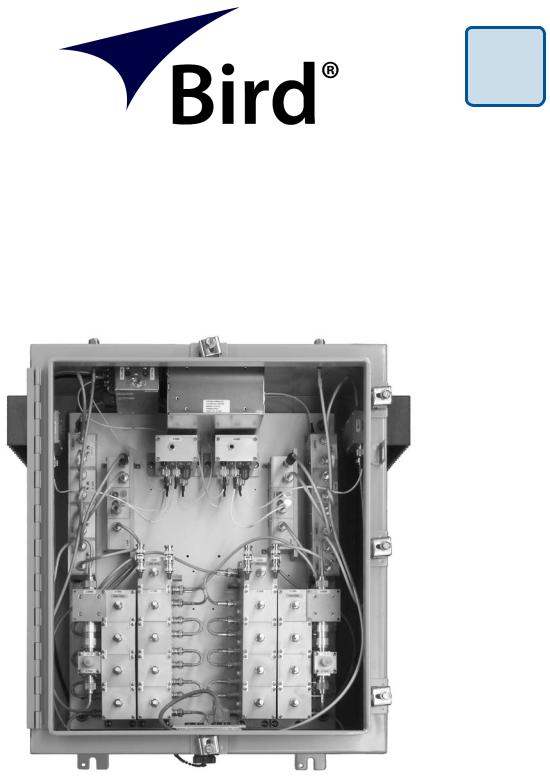
Manual No.
7-9408-2
Installation and Operation Manual for the Two-Way Signal Booster System
Model Number 61-38-05
30303 Aurora Rd. Solon, OH 44139 Tel: 1-440-248-1200 sales@birdrf.com www.birdrf.com
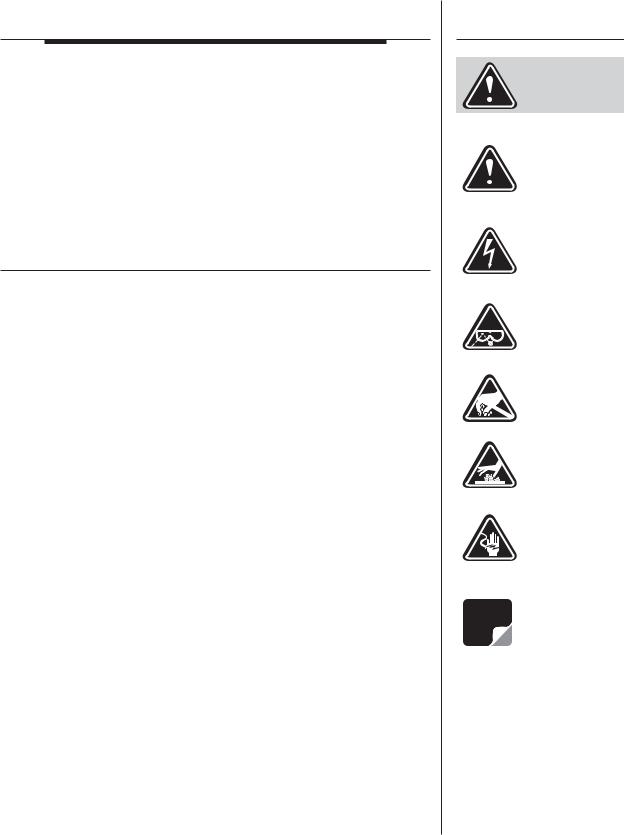
TERMS AND CONDITIONS OF SALE
Please visit the Bird website for complete information regarding terms
and conditions and warranty information.
http://www.birdrf.com/~/media/Bird/Files/PDF/Sales/bird-terms-and-
conditions-of-sales.ashx
Disclaimer
Product part numbering in photographs and drawings is accurate at time of printing. Part number labels on Bird products supercede part numbers given within this manual. Information is subject to change without notice.
Symbols
Commonly Used
WARNING
CAUTION or
ATTENTION
HighVoltage
Use Safety
Glasses
ESD
Electrostatic
Discharge
Hot Surface
Electrical Shock
Hazard
NOTE Important
Information
Copyright © 2018 Bird
First Printing: June 2005
Version Number |
Version Date |
|
|
1 |
06/14/05 |
|
|
1.1 |
07/12/05 |
|
|
1.2 |
07/25/05 |
|
|
2 |
07/29/05 |
|
|
|
|
|
|
|
|
|
|
|
|
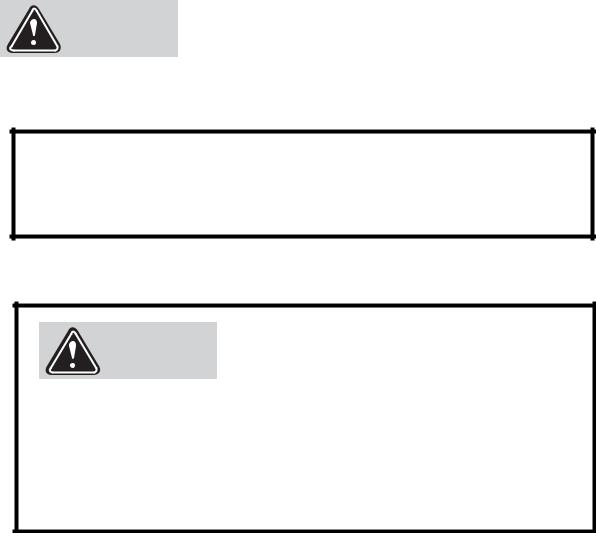
For Class A Unintentional Radiators
This equipment has been tested and found to comply with the limits for a Class A digital device, pursuant to part 15 of the FCC rules. These limits are designed to provide reasonable protection against harmful interference when the equipment is operated in a commercial environment. This equipment generates, uses, and can radiate radio frequency energy and, if not installed and used in accordance with the instruction manual, may cause harmful interference to radio communications. Operation of this equipment in a residential area is likely to cause harmful interference in which case the user will be required to correct the interference at his own expense.
Changes or modifications not expressly approved by WARNING Bird could void the user’s authority to operate the
equipment.
This device complies with Part 15 of the FCC Rules. Operation is subject to the following two conditions: (1) this device may not cause harmful interference and
(2) this device must accept any interference received, including interference that may cause undesired operation.
To satisfy FCC RF exposure requirements for transmitting devices, a separation distance of 70 Centimeters or more
WARNING should be maintained between the UPLINK antenna of this device and persons during device operation. To satisfy FCC
RF exposure requirements for transmitting devices, a separation distance of 21.5 Centimeters or more should be maintained between the DOWNLINK antenna of this device and persons during device operation. To ensure compliance, operations at closer than these distances is not recommended.
The antenna used for this transmitter must not be co-located in conjunction with any other antenna or transmitter.
Antenna System Installation
The antenna or signal distribution system consists of two branches. An uplink branch typically uses an outdoor mounted, unidirectional gain antenna such as a yagi and a downlink signal radiating system consisting of a network of zero-gain whip antennas or lengths of radiating cable usually mounted inside of the structure.
Even though the antenna system may not be supplied or installed by Bird Systems. The following points need to be observed because both the safety of the user and proper system performance depend on them.
1)Antenna system installation should only be performed by qualified technical personnel.
2)The following instructions for your safety describe antenna installation guidelines based on FCC Maximum RF Exposure Compliance requirements.
3)The uplink antenna is usually mounted outside and exchanges signals with the repeater base station or donor site. It is typically mounted perma- nently-attached to the building wall or roof. The gain of this antenna should
NOT exceed 10 dB. Only qualified personnel should have access to the antenna and under normal operating conditions, no one should be able to touch or approach it within 70 Centimeters (28 inches).
4)The downlink or in-building signal distribution system is connected to the downlink booster port using coaxial cable. The distribution system may use radiating coaxial cable or a network 1/4 wave whip antennas whose gain does not exceed 0 dB for any radiator. These antennas should be installed so that the user cannot approach any closer than 21.5 Centimeters (9 inches) from the antenna.
Table of Contents |
|
Section 1 |
|
Introduction ......................................................................................................... |
1 |
Note About Output Power Rating ........................................................................ |
3 |
Installation............................................................................................................ |
3 |
Cautionary Notes................................................................................................. |
4 |
Pre-RF Connection Tests.................................................................................... |
4 |
Test Equipment ................................................................................................... |
5 |
Antenna Isolation ................................................................................................. |
5 |
Procedure for Measuring Antenna Isolation ........................................................ |
5 |
Increasing Isolation.............................................................................................. |
6 |
Input Signal Levels .............................................................................................. |
6 |
Procedure for Measuring Input Signal Levels...................................................... |
6 |
Reduction of Incoming Signal Strength ............................................................... |
8 |
Setting Signal Booster Gain ................................................................................ |
8 |
Gain Reduction Methods ..................................................................................... |
8 |
Bypassing Amplifier Sections ............................................................................ |
9 |
Operation.............................................................................................................. |
9 |
Signal Flow........................................................................................................... |
9 |
System Components......................................................................................... |
10 |
Passive Filtering ................................................................................................ |
10 |
DC Regulator (3-5969) ...................................................................................... |
11 |
OLC Assembly (3-6280) .................................................................................... |
11 |
Pre-amplifier Stage (3-11423) ........................................................................... |
12 |
Driver Amplifier Stage (3-11423) ....................................................................... |
13 |
Hi Power Amplifier Assembly (3-11792) ............................................................ |
13 |
Signal Sampler (3-6999).................................................................................... |
13 |
Signal Sampler (3-3569).................................................................................... |
13 |
DC Junction Box (3-6254) ................................................................................. |
13 |
Power Supply Assembly (3-15503) ................................................................... |
13 |
Performance Survey.......................................................................................... |
14 |
Field Adjustments ............................................................................................. |
14 |
Filter Tuning....................................................................................................... |
15 |
Helical Preselectors ........................................................................................... |
16 |
Required Equipment ........................................................................................ |
16 |
Tuning Procedure ............................................................................................ |
16 |
Bandpass Filters ................................................................................................ |
17 |
Required Equipment ........................................................................................ |
17 |
Tuning Procedure ............................................................................................ |
17 |
Pseudo-Bandpass Filters .................................................................................. |
18 |
Required Equipment ........................................................................................ |
19 |
Tuning Procedure ............................................................................................ |
19 |
Notch Filters ...................................................................................................... |
20 |
Required Equipment ........................................................................................ |
20 |
Tuning Procedure ............................................................................................ |
21 |
Single Section Amplifier Subassemblies ........................................................... |
22 |
Amplifier Tuning............................................................................................... |
22 |
Required Equipment ........................................................................................ |
22 |
Adjustment Procedure ..................................................................................... |
23 |
Output Level Control (OLC) ............................................................................... |
25 |
Checking for Overload ..................................................................................... |
25 |
Table of Contents |
Manual 7-9408-2 |
07/29/05 |
Maintenance and Repair ................................................................................... |
26 |
Recommended Replacement Parts ................................................................. |
26 |
Conversion Chart .............................................................................................. |
26 |
Figures and Tables |
|
Figure 1: Front view of typical 61-38-05 system ................................................... |
2 |
Figure 2: Bottom view of the cabinet enclosure.................................................... |
3 |
Figure 3: Top view of the cabinet enclosure ......................................................... |
4 |
Figure 4: Measuring antenna isolation ................................................................. |
5 |
Figure 5: Measuring input signal levels ................................................................ |
7 |
Figure 6: Observing RF power output .................................................................. |
8 |
Figure 7: 1 stg/3 stg amplifier assembly 3-11423 ................................................. |
9 |
Figure 8: OLC assembly 3-6280......................................................................... |
12 |
Figure 9: Measuring signal booster gain ............................................................ |
14 |
Figure 10: Surveying performance ..................................................................... |
15 |
Figure 11: Preselector tuning ............................................................................. |
16 |
Figure 12: Observing preselector return loss ..................................................... |
17 |
Figure 13: Bandpass filter tuning ........................................................................ |
18 |
Figure 14: The pseudo-bandpass filter ............................................................... |
18 |
Figure 15: Tuning for maximum return loss ........................................................ |
19 |
Figure 16: Tuning for maximun attenuation ........................................................ |
20 |
Figure 17: The notch filter................................................................................... |
20 |
Figure 18: Tuning for maximum return loss ........................................................ |
21 |
Figure 19: Tuning for maximum attenuation ....................................................... |
22 |
Figure 20: Mechanical layout of single section amplifier .................................... |
23 |
Figure 21: Measuring amplifer gain .................................................................... |
24 |
Figure 22: Meqsuring input return loss ............................................................... |
24 |
Figure 23: Measuring output return loss ............................................................. |
25 |
Figure 24: Measuring reverse isolation .............................................................. |
25 |
Specifications .................................................................................................... |
27 |
Power Conversion Chart................................................................................... |
29 |
Notes................................................................................................................... |
32 |
Table of Contents |
Manual 7-9408-2 |
07/29/05 |
INTRODUCTION
This publication, Instruction Manual 7-9408, contains information to support the installation, operation, and maintenance of the model 61-38-05 signal booster system. Also included in this manual are the procedures necessary for field adjustments. It is assumed that procedures in this manual will be carried out by a skilled electronics technician who is familiar with the communications system. This manual also gives an elementary explanation of the operation of signal boosters and signal distribution systems.
The 61-38-05 booster family is designed to cover the frequency range of 138 to 174 MHz in two non contiguous bands, One version covers 138 to 144 MHz for operation in Canada and another version to cover 148 to 174 MHz. This version is also used to cover U.S. land-mobile frequencies from 150.8 to 174 MHz. Units for both bands share common active circuitry but differ in the passive filter units that duplex the downlink and uplink branches from a common input or to a common output. Because signal booster systems are often times subjected to very demanding environments with extreme conditions of temperature, moisture, dirt and corrosives, the system is housed in a high quality (NEMA style) enclosure. This type of housing
maintains its dimensional stability and appearance better than other materials. Figure 1 shows a front
view of the unit with the door opened.
The system uses linear RF active amplifiers, filters, OLC (output level control) circuitry, and DC power sources to adequately boost the level of the RF signals. Linear power amplifiers (Class-A) are used in the amplifier stages of this signal booster system in contrast to the highly efficient Class-C power amplifiers used in the output stages of most FM landmobile transmitters. Linear amplifiers are biased for a relatively high continuous DC current drain that does not change with changing RF drive levels.
Class-A amplifiers generally have the lowest efficiency of the various amplifier types, typically in the range of 25-33%. They also draw relatively high
current levels on a continuous basis, making heat dissipation an important factor. Their biggest advantage is faithful reproduction of the input waveform which results in the lowest levels of intermodulation distortion products (IM) of all the classes of amplifiers. IM generation is a serious design consideration when two or more channels are simultaneously present in the same amplifier stage.
Preselector filters are used in the system to provide a number of functions including; reduction of the level of undesired signals that may enter the system and also help suppress any IM products that may be inadvertently generated. They also produce a convenient impedance characteristic that allows multiple branch paths to be tied together to a common input/output port. This is accomplished using critical length cables from the filter assemblies to a tee junction.
The output level of any signal passing through a signal booster is determined by the input signal level, the gain of the booster, and the maximum output power per carrier rating of the booster. The high power output stages used in the signal booster may be damaged by excessive input signals. An output level control (OLC) circuit is added to each amplifier chain to protect the amplifiers and reduce spurious signals. The OLC circuit is designed to maintain the maximum output level of the booster during times of excessive input signal levels.
OLC circuitry actuates when a predetermined maximum output level is reached. The output power level in all OLC branches is sampled, and then fed to a detector circuit which generates a DC voltage proportional to the output power level. The DC output of the detector is then applied to a control circuit which develops a voltage used to control a variable electronic attenuator. The electronically controlled attenuator is placed within the amplifier signal path and reduces the incoming signal by an amount necessary to keep the power from exceeding the maximum safe level. The gain reduction range is typically from 5 to 40 dB which is more than adequate for most real life situations.
OLC circuitry should not be considered a panacea for a poor system design. One undesirable affect of OLC is that the signal level of all signals being processed by the branch will be reduced when the cir- c u it r y i s ac t i vat ed . T hi s m ea ns t ha t th e
Bird |
Manual 7-9408-2 |
07/29/05 |
Page 1 |
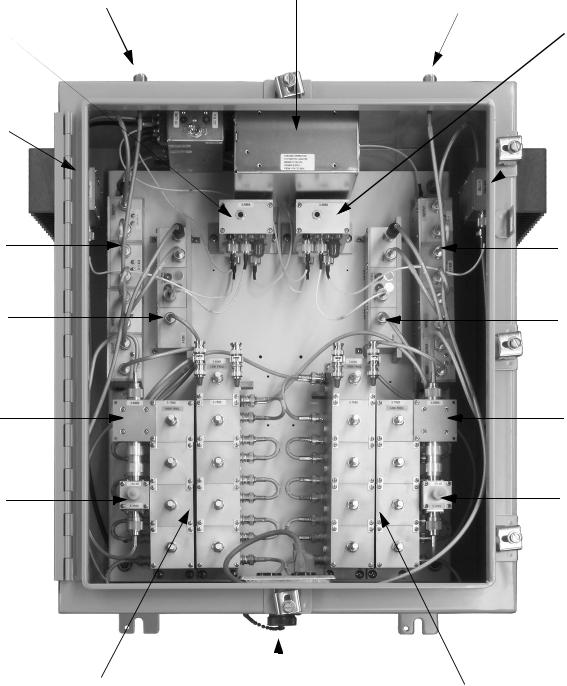
RF In/Output |
Power Supply |
RF In/Output |
|
Connector |
Assembly 3-11503 |
||
Connector |
|||
|
|
Regulator
3-5969
High Power
Amplifier
Assembly
3-11792
1 stg/3 stg Amplifier Assembly 3-11423
OLC
Assembly 3-6280
Signal
Sampler
3-6999
Signal
Sampler
3-3569
Filtering |
|
Filtering |
|
||
|
|
|
|
Backup Battery |
|
|
connects here |
|
Figure 1: Front view of a typical model 61-38-05 signal booster system.
Regulator  3-5969
3-5969
High Power
Amplifier
 Assembly
Assembly
3-11792
1 stg/3 stg Amplifier Assembly 3-11423
OLC
Assembly 3-6280
Signal
Sampler
3-6999
Signal
Sampler
3-3569
Bird |
Manual 7-9408-2 |
07/29/05 |
Page 2 |

performance of the system is actually decreased on all other channels within the branch as long as gain reduction is taking place. This implies that OLC has been designed to handle short term or transient overdrive episodes only.
Note About Output Power Rating
A single maximum output power rating does not apply to broadband signal boosters because the linear amplifiers (Class A) used in them may have to process multiple simultaneous signals. Under these conditions, the questions of power rating becomes more complex.
When more than one signal is amplified, a number of spurious signals will also appear in the amplified output. They are referred to as intermodulation distortion products, more commonly called I.M. These spurious products would not be present in a perfectly linear amplifier but as in all things, something short of perfection is realized. The net result is that the total power out in each signal will be somewhat less than the single carrier rating in order to maintain adequate I.M. performance.
INSTALLATION
The layout of the signal distribution system will be the prime factor in determining the mounting loca-
tion of the signal booster enclosure. However, safety and serviceability are also key considerations. The unit should be located where it cannot be tampered with by unauthorized personnel yet is easily accessible to service personnel using trouble shooting test equipment such as digital multimeters and spectrum analyzers. Also consider the weight and size of the unit should it become detached from its mounting surfaces for any reason.
Very little is required to install this signal booster. The unit should be bolted in its permanent position using lag bolts or other suitable fasteners. Make sure there is an unobstructed airflow over the external heatsinks. Safety and serviceability are key considerations. The signal booster cabinet will stay warm during normal operation so in the interest of equipment longevity, avoid locations that will expose the cabinet to direct sun or areas where the temperature is continually elevated.
The signal booster is designed to be powered from 120 VAC and a conduit entry box is provided at the bottom of the enclosure for bringing the AC line into the cabinet. AC line connections should be made in accordance with local electrical and building codes. The battery backup system should also
Figure 2: Bottom view of cabinet enclosure.
Bird |
Manual 7-9408-2 |
07/29/05 |
Page 3 |
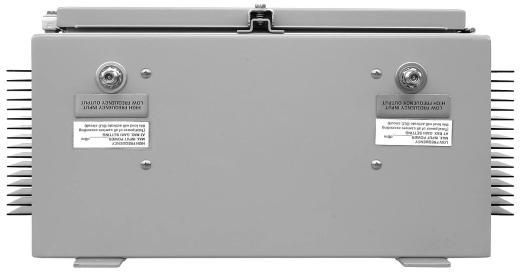
be connected at this time. The 3-pin MS style connector for the backup power system is labeled and is located on the bottom of the enclosure. A photo-
graph of the bottom of the cabinet is shown in Figure 2.
Connection of RF to the unit is made via “N” female connectors located on top of the cabinet. These connectors are individually labeled “High Frequencies IN Low frequencies OUT” and “Low Frequencies IN High Frequencies OUT”. Care should be used when making connections to these ports to insure the correct antenna cable is connected to its corresponding input / output port or the system will not work. The use of high quality connectors with gold center pins is advised. Flexible jumper cables made of high quality coax are also acceptable for
connecting to rigid cable sections. A photograph of the top of the cabinet is shown in Figure 3.
CAUTIONARY NOTES
The following cautions are not intended to frighten the user but have been added to make you aware of and help you avoid the areas where experience has shown us that trouble can occur.
1) Just like the feedback squeal that can occur when the microphone and speaker get too close to each other in a public address system, a signal booster can start to self oscillate. This will occur
when the isolation between the input antenna or signal source and the output antenna or signal distribution system does not exceed the signal booster gain by at least 10 dB. This condition will reduce the effectiveness of the signal booster and possibly damage the power amplifier stages.
2) The major cause of damage to signal boosters is the application of input RF power levels in excess of the maximum safe input. This can happen inadvertently when connecting a signal generator with full power out to one of the inputs or by a very strong signal that is far stronger than expected. The Maximum Safe Power input level for your unit can be found on the laminated tag affixed to the top of the cabinet near the RF input/outputs. Following the pre-installation checks listed below will help to avoid these two problems.
PRE-RF CONNECTION TESTS
Certain characteristics of the signal distribution system should be measured before connecting it to the signal booster. This step is necessary to insure that no conditions exist that could possibly damage the signal booster and should not be skipped for even the most thoroughly designed system. Two characteristics need to be measured; antenna isolation and input signal levels.
Figure 3: Top view of cabinet enclosure.
Bird |
Manual 7-9408-2 |
07/29/05 |
Page 4 |
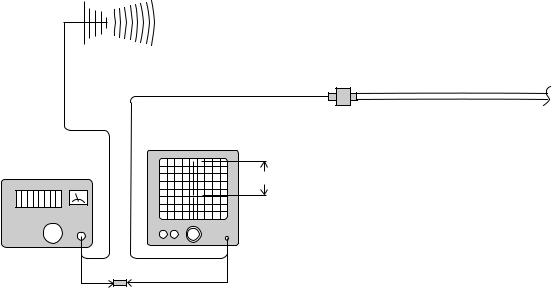
Test Equipment
The following equipment is required in order to perform the pre-installation measurements.
1)Signal generator for the frequencies of interest capable of a 0 dBm output level. Modulation is not necessary.
2)Spectrum analyzer that covers the frequencies of interest and is capable of observing signal levels down to -100 dBm.
3)Double shielded coaxial test cables made from RG142 or RG55 coaxial cable.
Antenna Isolation
Antenna isolation is the signal path isolation between the two sections of the signal distribution system that are to be connected to the signal boosters antenna ports. Lack of sufficient isolation between the input and output antennas can cause the amplifiers in the system to oscillate. This can happen at a high enough level to damage the power amplifier stages. In general, if one or both antenna ports are connected to sections of radiating coaxial cable (lossy cable) via short jumpers of
non-radiating cable the isolation will be more than adequate because of the high coupling loss values that are encountered with this type of cable. When a network of antennas are used for the input and output, this problem is much more likely. Isolation values are relatively easy to measure with a spectrum analyzer and signal generator.
Procedure for Measuring Antenna Isolation
1)Set the signal generator for a 0 dBm output level at the center frequency of one of the signal boosters passbands.
2)Set the spectrum analyzer for the same center frequency and a sweep width equal to or just slightly greater than the passband chosen in step one.
3)Connect the test leads of the signal generator
and the spectrum analyzer together using a female barrel connector, see Figure 4. Observe the signal on the analyzer and adjust the input attenuator of the analyzer for a signal level that just reaches the 0 dBm level at the top of the graticule.
EXTERNAL |
|
|
ANTENNA |
|
|
SPECTRUM |
INTERNAL |
|
SIGNAL DISTRIBUTION |
||
ANALYZER |
||
SYSTEM |
||
SIGNAL |
||
|
||
GENERATOR |
|
|
|
ISOLATION (dB) |
ZERO LOSS
REFERENCE
Figure 4: Typical test equipment setup for measuring antenna isolation.
Bird |
Manual 7-9408-2 |
07/29/05 |
Page 5 |
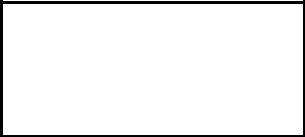
4)Referring to figure 4, connect the generator test lead to one side of the signal distribution system (external antenna) and the spectrum analyzer lead to the other (internal distribution system) and observe the signal level. The difference between this observed level and 0 dBm is the isolation between the sections. If the signal is too weak to observe, the spectrum analyzer's bandwidth may have to be narrowed and its
input attenuation reduced. Record the isolation value. The isolation value measured should exceed the amplifier gain figure by at least 15 dB.
It is wise to repeat the procedure listed above for measuring antenna isolation, with the signal generator set to frequencies at the passbands edges in order to see if the isolation is remaining relatively constant over the complete width of the passband. Also, the procedure should be repeated for each of the remaining channels in the system.
Increasing Isolation
If the measured isolation does not exceed the amplifier gain figure by at least 15 dB then modification of the signal distribution system is required. Alternately, the gain of the signal booster can also be reduced to insure the 15 dB specification is met. If the isolation cannot be increased then the amount of gain reduction required is determined as shown in the following example.
EXAMPLE
Gain Reduction (dB) = Minimum Isolation (dB) -
Measured Isolation (dB)
If the measured isolation is -75dB and the minimum isolation is -80dB then the amount of gain reduction required is: -80dB - (-75) = -5 dB
a)Unintended signals entering the system. Primarily caused by radios operating on channels that are within the operational bandwidth of the signal booster. Sometimes this will be a transient problem caused by mobile units when they transmit while in close proximity to your system.
b)Hand-held and mobile units that approach much closer than expected to one of the antennas in the signal distribution system.
c)Unexpected signal propagation anomalies. Building geometry can cause signal ducting and other phenomena that cause signal levels that are much stronger (or lower) than expected.
d)Lower than estimated signal attenuation causes signals to be unusually strong. Higher losses can also occur giving weaker signals than desired.
e)Signal booster model with excessive gain. In systems that have an existing signal booster, it is sometimes assumed that an identical unit should be installed when expanding the system to provide extended coverage. In most cases, a signal booster with far less gain than the first is required.
f)Improper installation or application of signal splitters or directional couplers in the signal distribution system. This is usually the cause of too low a signal level but deserves mentioning here. Signal splitting needs to be done with constant impedance signal splitters so that the proper power splitting ratios and VSWR are maintained. Using tee connectors by themselves is inviting trouble. Directional couplers must be connected with regard to their directionality and coupling levels or improper system signal levels may result.
Input Signal Levels
Excessive input signal levels can damage the signal booster. Although this problem is less severe in OLC protected branches, strong signals may cause sudden reductions in gain and an associated decrease in the desired output signal strength. Even in the most carefully designed signal distribution systems, unpredictable situations can arise that can cause this trouble. A few of the more common causes are:
Procedure for Measuring Input Signal Levels
1)Set a spectrum analyzer for the center frequency of one of the branches (look at the specification drawing for this information).
2)Set the analyzer sweep width so that the entire passband frequency range can be observed.
Bird |
Manual 7-9408-2 |
07/29/05 |
Page 6 |
